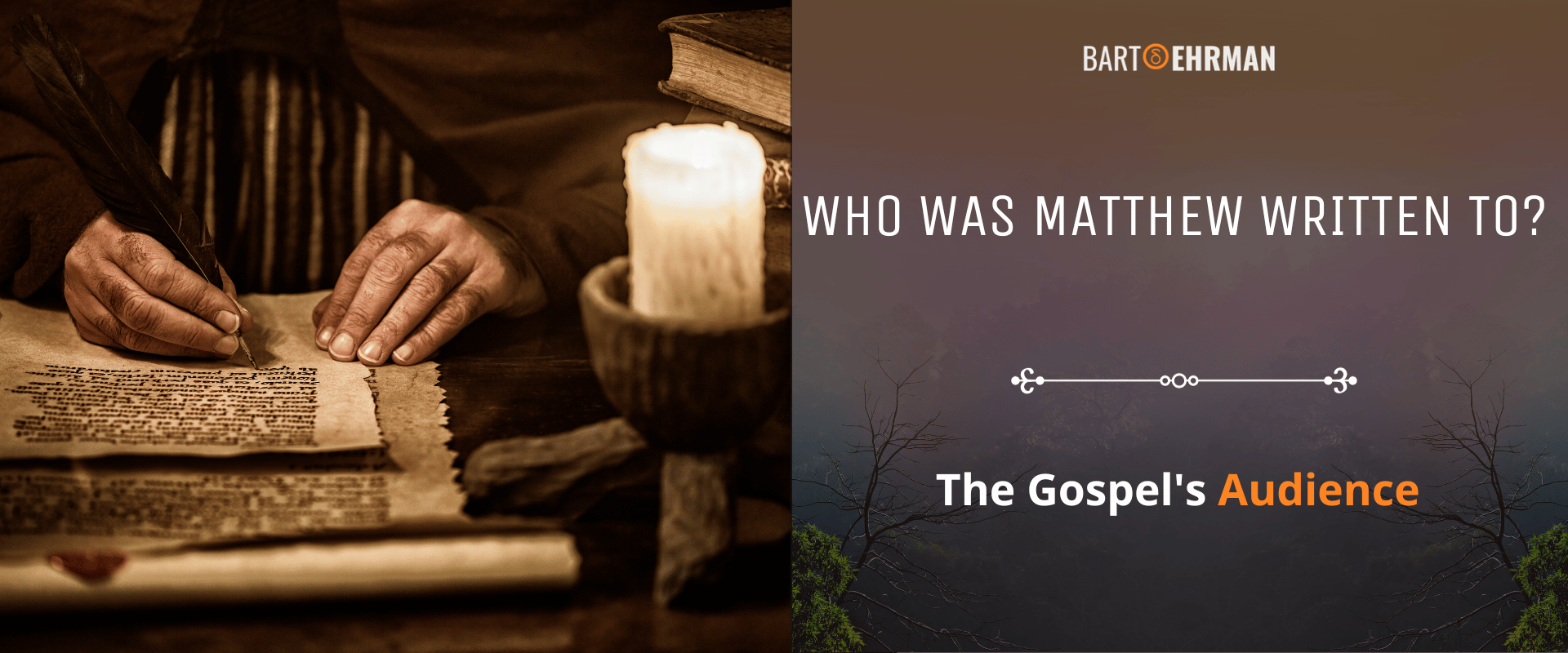Who Was Matthew Written To? The Gospel's Audience

Written by Joshua Schachterle, Ph.D
Author | Professor | Scholar
Author | Professor | BE Contributor
Verified! See our editorial guidelines
Verified! See our guidelines
Date written: October 20th, 2023
Disclaimer: The views and opinions expressed in this article belong to the author and do not necessarily match my own. - Dr. Bart D. Ehrman
After reading the Gospel of Matthew, you might wonder who it was written to. In other words, who was Matthew’s audience? In this article, I’ll explore what we can know about the author of Matthew. Then, using that information, I’ll address who the author Matthew wrote his Gospel for.

Who Wrote the Gospel of Matthew?
Matthew, like all the Gospels, was originally anonymous. In other words, the author chose not to sign his name to the text. Many scholars believe that this is an indication that the author considered the Gospel the product of a community rather than a single individual.
Whatever the reason, the lack of a signature means that we’ll never truly know the name of the individual that wrote the Gospel of Matthew. We can, however, know some things about this author.
By the way, during the first century, more men than women were literate. Therefore, most scholars assume that the author of this work has a masculine identity.
Was Matthew Jewish?
Matthew is called the most Jewish of the Gospels for several reasons.
The genealogy of Jesus at the beginning of the Gospel links him directly not only to Abraham, Isaac, and Jacob but also to David, Israel’s greatest king. It seems unlikely that a gentile author would take such great pains to link Jesus to the greatest Jewish patriarchs.
Walter Wilson also notes that the author clearly has knowledge of Hebrew. In addition, he makes numerous references to the Hebrew Bible in the text, highlighting prophecies he believes are relevant, and insisting on the importance of Torah observance. All of this definitely points to a Jewish author for Matthew.
He Was Probably not from Palestine
The Gospel of Matthew was written in Greek, not the Aramaic language dominant in Palestine at the time.
Most scholars agree that Antioch, Syria is the most likely location for the writing of Matthew, since Greek was the primary language spoken there.
In addition, Aaron Gale, in the Jewish Annotated New Testament notes that Matthew is the only Gospel that mentions that Jesus was recognized in Syria during his lifetime. Later New Testament texts also mention that a community led by Jesus existed there (See Acts 11:19-27, 13:1, Gal 2:11). Moreover, Peter, who was one of the leaders of the disciples, seems to have links to the city (Matt 16-17-19, Gal 2:11).
Wilson also points out that Antioch had a large population of Jews and Jewish-Christians, making it even more likely as the place where Matthew was written.
For Whom Was Matthew Written?
For the most part, writers always have an audience in mind. They shape their writing to fit this target audience. So who was Matthew’s written to?
In Scripting Jesus, L. Michael White writes that Jesus is portrayed in three ways in Matthew.
He is the Davidic Messiah, which again is shown in his birth narrative and genealogy.
He is the new Moses, clarifying and even modifying the law of Moses.
He is a teacher of righteousness who is more authoritative than the teachers of his day.
These are all particularly Jewish ways of viewing Jesus. We can therefore assume that Matthew’s primary audience consisted of Jewish Christians. Let’s explore those three ways a bit further to understand Matthew’s readers.
Jesus as Davidic Messiah
Matthew often ends a particular story with some version of the phrase “All this took place to fulfill what had been spoken by the Lord through the prophet.” What does this tell us about Matthew’s audience?
The Messiah had to fulfill ancient prophecies. Matthew included these prophecies from the Hebrew Bible, interpreted to fit his narrative, because this mattered to a Jewish audience in 1st-century Palestine. Many people at that time claimed to be the Messiah, but Matthew used proof-texts from the Hebrew Bible to argue that only Jesus was the real Messiah.
We can assume, then, that Matthew’s audience were Jews who believed that Jesus fulfilled Messianic prophecy.
Jesus as the New Moses
In the Sermon on the Mount from Matthew 5, Jesus says “Do not think that I have come to abolish the Law or the Prophets; I have come not to abolish but to fulfill.” As the Messiah, he is there to fulfill prophecy. As the new Moses, however, he is there to make sure that Jews understand the true interpretation of the Torah.
In this same sermon, Jesus often starts his discourse on the Torah by saying “You have heard it said… but I say…” Here’s an example:
“You have heard that it was said to those of ancient times, ‘You shall not murder,’ and ‘whoever murders shall be liable to judgment.’ But I say to you that if you are angry with a brother or sister, you will be liable to judgment, and if you insult a brother or sister, you will be liable to the council, and if you say, ‘You fool,’ you will be liable to the hell of fire.”
Note the formula here: Jesus acknowledges the letter of the law, but then says that his followers should go even further than the law requires. This indicates that while the Law is important for Matthew’s audience, Jesus interpretation and fulfillment of the Law is more important.
Jesus as a Teacher of Righteousness
In the Sermon on the Mount, Jesus says this:
For I tell you, unless your righteousness exceeds that of the scribes and Pharisees, you will never enter the kingdom of heaven.
The Pharisees are depicted in Matthew as strict interpreters of the Law of Moses, as well as Jesus’ opponents. Here, Matthew paints Jesus as the strictest teacher of all, with the authority to modify the requirements of the law.
Scholars know that this depiction of the Pharisees isn’t historically accurate. What it does indicate, however, is that Matthew’s community, his audience, had fallen out with the Jewish religious authorities of their day and were thus trying to show that their form of Judaism was valid.
What does this say about Matthew’s audience? They considered themselves Jews for whom Torah interpretation and observance was paramount. Therefore, Matthew’s Jesus shows himself as the definitive teacher of Torah.

The Five Discourses in Matthew
Matthew has Jesus give five sermons, which scholars call the five discourses. Looking at their themes can tell us a lot about Matthew’s target audience.
The Sermon on the Mount focuses on observance of the Jewish Law.
The Mission Discourse is about the pressures of following Jesus during persecution.
Parables of the Kingdom explains the coming kingdom of heaven and outlines the proper choices and behaviors that will bring this kingdom about.
On Discipline and Forgiveness addresses divisions within Matthew’s community and how to resolve it.
On Judgment, contains warnings to the Jewish religious authorities (“Woe to you, Pharisees!”) and a speech about the end of the current world.
The common theme in these sermons, according to Walter Wilson is “identifying the ideals of discipleship, while… [exposing] the challenge of meeting these ideals, a challenge that the reader is implicitly invited to take up.”
This demonstrates that Matthew’s audience consisted primarily of a community of Jews devoted to living according to the teachings of Jesus.
But there is a twist!
Could Gentiles be Part of Matthew’s Audience?
At the end of Matthew, a resurrected Jesus says this:
Go therefore and make disciples of all nations, baptizing them in the name of the Father and of the Son and of the Holy Spirit and teaching them to obey everything that I have commanded you.
This seems to suggest that Jesus wanted his followers to include gentiles in their ranks. What can this tell us about Matthew’s audience?
Remember that Jesus’ conflicts with the Pharisees in Matthew likely meant that the Jewish authorities of Matthew’s time did not accept Jesus-followers as part of the Jewish community. This implies that most Jewish religious leaders were not convinced that Jesus was the Messiah.
Wilson therefore says that the inclusion of gentiles in Jesus’ commission shows that since Jewish authorities were not open to Jesus, Matthew’s Jewish community expanded to include gentiles.
Conclusion: For Whom the Gospel of Matthew Written?
The author of Matthew was a Jew who followed the teachings of Jesus. Here’s what we can surmise about his target audience.
Most of them were Jewish. Matthew’s community consisted mainly of Jewish Christians who followed both Jesus and the Jewish Law.
They probably lived in Antioch, Syria. There were many Jews and Jewish Christians living in Antioch at the time. In addition, Matthew is the only Gospel to mention Syria as a place where Jesus was well-known.
They believed that Jesus was the long-awaited Jewish Messiah. Jesus was the fulfillment of prophecies made centuries before and written down in the Hebrew Bible.
They believed that Jesus had made the Jewish law more rigorous. Jesus’ discourses on what the law said often stated that his followers should live even more strictly than the Jewish religious authorities.
Some of them were gentiles. Matthew sees Jesus through a decidedly Jewish lens. However, it would seem that since the Jewish authorities in Matthew’s time did not accept Jewish Christians, Matthew’s community opened themselves to gentiles as well.
